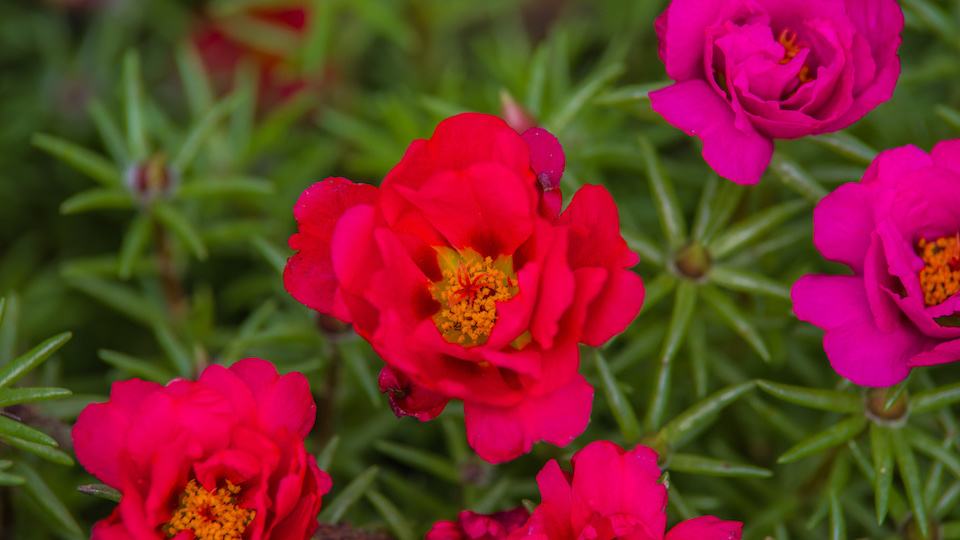Portulaca grandiflora, or moss rose, is a member of the purslane) Portulacaceae family. This small family contains less than 100 species, including the edible purslane weed, which is a prolific self-seeder. Moss rose plants are beautiful when used in pots and container gardens and also make an excellent ground cover. Don’t let this plant’s small stature fool you; portulacas are sturdy and beautiful at the same time. They are a great option for hot and dry climates and have a short and sweet spreading habit.
Portulaca is truly a beautiful, low growing plant that is native to Brazil, Argentina, and Uruguay. Besides buying starters at your local garden center, you can also start portulaca from seeds or cuttings.
Plants bloom from June until the first fall frost hits. The flowers grow at the tips of reddish stems and resemble old-fashioned roses and can be single or double-layered. Colors are bright and cheery in shades of pink, red, white, orange, and yellow, and the bright yellow center adds an extra colorful spark. Once flowers fade, the leaves at the end of stems look like star-shaped crowns behind seed pods that open into cups when the teeny-tiny seeds ripen.
Using moss rose in your garden
Moss rose plants tolerate dry, sandy, and somewhat poor soil but will grow with vigor when you provide regular irrigation and loads of beneficial nutrients. Whichever way you grow them, portulaca will reward you with plenty of flowers; however, you will find that under ideal conditions, their foliage will be thickly matted and quite green, and their flowers will be prolific.
If you have some sandy soil or ugly areas that you want to hide in your garden, moss rose plants will do the trick. Since these little gems thrive in heat, they make an excellent border plant along concrete, asphalt and other surfaces that might “fry” more delicate plants. Surprisingly, they will also tolerate foot traffic. I love to plant moss rose between stepping stones and experience the wispy feel between my bare toes. You can also fill in cracks in old stone walls, letting plants dribble over the edges for an eye-catching cascade of color.
As mentioned earlier, portulaca also makes an excellent container plant, and when mixed with sedums like stonecrop, they do well as part of a living roof. I have also used moss rose to cover bulb beds. Not only do they help to keep weeds down, but they also make a beautiful backdrop for bulb plants like tulips and irises.
What portulaca needs to grow well
Hardiness Zone – Heat-loving portulaca grows as a hardy/half-hardy annual in USDA hardiness zones 2 through 11.
Sunlight – Moss rose thrives in full sun. If you plant in the shade, blooms will not open, and stems will be scraggly and weak.
Soil – Soil must be well-draining and preferably compost-rich with a pH between 5.5 and 7.0
Moisture – If your soil is sandy, water frequently. If you have humus-rich ground, let it dry out between watering. Be careful not to overwater. A light watering is all that is necessary as their roots are very shallow.
Planting seeds
Plant seeds outdoors as soon as the last frost has passed. Prepare the planting area by removing clumps and debris from the top inch of the soil and work in some well-aged compost. Scatter seeds or gently rake them into the soil but be sure not to cover them with more than ⅛” of soil, as they need sunlight to germinate. Don’t let seeds dry out either, as they also need moisture to germinate and will pop up 7 to 14 days after planting. The ideal spacing is 12 inches, but they are easy to thin if they are too crowded. Look for baby plants to pop up 7 to 14 days after planting.
Pests, disease and caring for moss rose
There are a few pests that like moss rose, such as aphids and juice-loving bugs. However, they generally do not do much damage. The best way to deal with these pests is to give plants a quick spray early in the day with a garden hose. You can also add a little dish soap to water and spray this on plants.
Portulaca plants have a very shallow root system, which makes them susceptible to rot. Be careful not to overwater plants, making them soggy as this will encourage rot. If you live in humid areas, let plants dry out between watering.
Moss rose will reseed with pleasure, which means that you will have a new crop of these beauties each season. To keep them looking their best and encourage new blooms, make sure that you deadhead flowers regularly.
Provide a nitrogen-heavy fertilizer when plants are young and switch this up to a phosphorous-heavy food just before they are ready to bloom. To keep plants healthy, fertilize them again about halfway through the season.
When you look after portulaca, these hardy little beauties will make you smile every time you look at them!
-Susan Patterson



